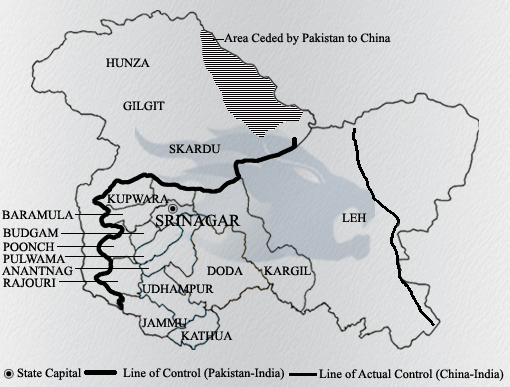J & K INSURGENCY

Causes of the Jammu and Kashmir Insurgency:
The insurgency in Jammu and Kashmir is a combination of multiple factors. Some of the factors to highlight are as follows:
POLITICAL FACTORS :
Disputed Status: The disputed status of Jammu and Kashmir, an old unfinished business between the two countries - has continued to exacerbate tensions among separatist elements.
Political disenfranchisement: Insurgency is due to political disenfranchisement and lack of real democratic step up from some secessionist segment in Kashmir.
Emergence of Human Rights Violations: Widespread allegations that security forces are violating human rights have made a large proportion of the population feel alienated and increasingly resentful.
SOCIO-ECONOMIC FACTORS:
High Unemployment - especially young people, who have high rates and feel frustrated and hopeless.
Economic Disparity: Sight of economic disparity between different regions and communities within Jammu & Kashmir has fuelled sense of marginalization and resentment.
Education Unavailable: Millions of young people are deprived education by lack of access to quality schools (staggering class sizes), affecting both social upward mobility and economic opportunity.
RELIGIOUS FACTORS:
Religious Identity: Some militant groups play on religious identity to gather support for their cause, and sell the conflict as a struggle against India with some quasi-religious overtones.
Radicalization: Foreign extremist groups have taken place and based some radical ideas on how to attract young individuals.
EXTERNAL FACTORS:
cross-border terrorism: Pakistan's backing of dozens of militant groups which operate inside Jammu and Kashmir have added to the fires in this state.
Heightening of Geopolitical Rivalry: The conflict is intensified because India and Pakistan both respond to the same situation with geopolitical calculation rather than focusing on a peaceful resolution;
ADDITIONAL POINTS:
The conflict is also influenced by the historical background of injustices due to 1947 partition of India and legacy status a being princely state before independence, such as Jammu et Kashmir.
There is also the matter of internal power struggles within Jammu and Kashmir and influence from various political factions that cannot be discounted.
The conflict has wrought havoc on the lives of people in Jammu and Kashmir, causing mass exodus from rural areas, loss of life during anti-militancy operations or insurgency-related incidents, massive human rights abuses by both security forces (police & army)and militant groups.
for which virtually no perpetrator have been held accountable as there is total impunity. widespread torture ,injuries .Women suffered immensely to militarisation with molestation/rape becoming normal .This applies much more exclusively for the post 1989 era.
MAJOR STEPS TAKEN BY THE INDIAN GOVERNMENT
Legislative Measures:
Armed Forces (Special Powers) Act: It is an act that gives special powers to the Indian Armed forces in territories deemed disturbed, due to violent insurrection or insurgency. However, it has faced criticism for potential human rights abuses.
Unlawful Activities (Prevention) Act(UAPA): This act permits detention of suspected terrorist.
Public Safety Act (PSA ) - The PSA allows for the preventive detention of a person without trial for up to two years.
SCHEMES:
Prime Minister's Development Package (PMDP): IN 2015 the government announced a package of Rs.80,000 crore for the development of Jammu and Kashmir .
Brave To Village (B2V): Launched in 2019 with the aim to connect hearts of village peoples and resolve their grievances, etc.
Project ANR (Himayat Merge) for secretariats - Schemes like Pradhan Mantri Kaushal Vikas Yojana (PMKVY) and Himayat aim to provide skill development opportunities to youth in Jammu And Kashmir.
OTHER MAJOR MEASURES:
Ceasefire: Pulwama attack led to LoC peace between India and Pakistan,
Dialogue with Separatist Leaders: The government has held talks in the past with some separatist leaders but they were not able to yield results.
Rehabilitation Programs for Ex-Militants: Program like "Surrender-cum-Rehabilitation" policy which facilitate the return of former militants into mainstream society.
Promoting Inter-Community Harmony: Initiatives like the "Kashmiryat" campaign aim to promote inter-community harmony and understanding.
WAY FORWARD JAMMU AND KASHMIR INSURGENCY
With the Jammu and Kashmir insurgency, there are no easy answers. Meanwhile, a well-thought-out multi-stakeholder approach that tackles the underlying reasons for this conflict and advocates inclusivity, development as well as dialogue may lead us towards an amicable solution.
ADDRESSING ROOT CAUSES:
Countering Cross-Border Terrorism: Terrorism continues to emanate from Pakistan and addressing the same by way of counter-terrorism efforts across borders, remains important.
Addressing Socio-Economic Disparities: This is a long-term project, as much of it comes down to investing time and money into education, skills development (e.g., access to vocational training programs), job creation etc.
Promoting Political Participation: The need of the hour is to foster an enabling environment for meaningful political participation and address the concerns among marginalized sections.
Protecting Human Rights: Accountability for human rights abuse and rule of law must be guaranteed to help build trust.
FOSTERING INCLUSIVITY AND DIALOGUE
Engaging all stakeholders: Political leaders, civil society and the youth across (from) sections of the society is a must.
Support Inter-Community Harmony: It is important to help bridge the gap and elevate communication between different communities, which will support social cohesion.
Dealing with Historical Wounds: Recognizing and dealing with historical wounds can foster trust built on reconciliation.
LONG-TERM DEVELOPMENT FOCUS
Infrastructure Investment: One of the most important things that can be done for any economy is to enhance infrastructure, which includes transportation, communication and energy.
Boosting Tourism: Capitalising on potential for tourism development can generate jobs and stimulate the economy.
Improving Education and Healthcare: Investing in education, to be able provide quality schooling so that you can move from being a learned illiterate civilisation towards becoming an institution.
investing health-care services: we should try it - after all we are asking people to put their faith into our hands.
Conclusion:
The Jammu and Kashmir insurgency cannot be resolved with a single shot approach but an effective long-term strategy may ease the conflict by tackling both security as well political aspects. A focus on inclusivity, development and dialogue would provide an opportunity for a peaceful future in Jammu & Kashmir most importantly of all with An Eye to the Long Run.

-1721391937657.png)

